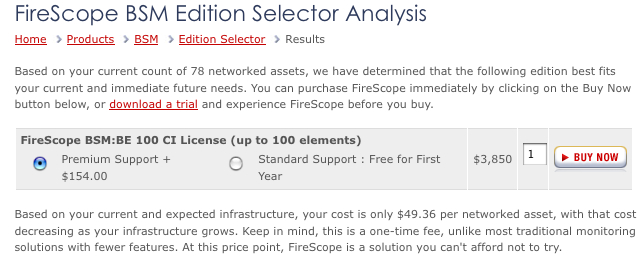Firescope crushes the BSM price point

Earlier today I spoke with Mark Lynd, president of Firescope, a company that's trying with very little funding - $4 million at the last count - to bring Business Service Mangement (BSM) to the mass of smaller enterprises. Earlier in the week, the company launched BSM-Business Edition at a starting price point of $2,450. The reality is somewhat higher.
Firescope provides potential customers with a handy product selector which requires users to enter IT asset inventory numbers across a range of asset types like servers, routers, switches, VoIP servers and so on. Using this tool is not likely to be a problem for SMB's though I suspect thatorganisations with more than say 30 application and database servers might be challenged to get the numbers right.
In my imaginary configuration of 78 networked assets, 60 of which were networked printers, Firescope recommended a solution that costs $3,850. I don't have a problem with that as such but do feel that what seems to be arbitrary pricing based on a hardware 'headcount' isn't really addressing the problem of BSM pricing in quite the manner I'd prefer. Compared to other solutions, Firescope BSM-BE is unquestionably hitting an attractive price point but I wondered what might happen in a more complex environment. 136 networked assets, which this time included 100 printers took me to $5,450.
The flip side of a low price is that the service inevitably gets compared to higher priced offerings and those of traditional services like HP OpenView. But as Lynd correctly pointed out: "Products coming from the higher priced vendors offer plenty of functionality but you find that only 10% gets used while paying 100% of the price. We're trying to get to that 80-90% SMBs need at a lower price point." It's a commodotizing play that has worked well elsewhere, Lynd citing SolarWinds as one example.
Even so it is hard to complain about a service that is breaking ground not just on price but in design and approach to market. The company has taken advantage of Web 2.0 technologies, AJAX and open source as a way of allowing it get to market quickly at modest cost to itself while keeping things simple for the newbie. It provides a transparent, try before you buy option that allows sysadmins the opportunity to road test BSM-BE for themselves. Next week, it will release a free to use workbench that provides an: "IT service modeler and SNMP walker/browser."
But what about depth of functionality? Is it all an SMB might need? From a usability perspective, Firescope has worked hard to make it easy to understand what the user, whether a sysadmin, CIO or end user sees on their screen. This has been achieved by attention to the differing needs of different roles within an organization. From what I've seen, that works well. I'm less sure about reporting which is limited to around 40 standard report types in the BE edition and no customizations. I like the fact Firescope can provide information on the financial impact of SLAs and handles multiple SLAs per service used. Basics like availability, SLA, performance and security management are all there.
However, Firescope is not without critics. In a PC World article, a competitor asserted that:
"The idea of providing some BSM functionality to smaller IT shops is noble and an interesting idea, but I'd recommend being cautious about raising expectations. ... BSM doesn't lend itself to tossing cheap and cheerful code over the wall and hoping it will self-install and model critical IT services independently," said Frank Strong, marketing communications director for Managed Objects, via e-mail.
I usually take these kind of shots with a pinch of salt but you do have to ask - where is the cut off point before engineers need spend time making sure they're looking at the right things? Perhaps the answer comes from the company's blog:
I knew we had something when a graphic designer friend, someone who thought TCP/IP was a brush setting in Photoshop, was able to get FireScope up and running, collecting data and delivering financial analysis of his technology in a little under an hour.
I can't help but think Firescope is onto something. The company is achieving an 8% conversion rate from downloads. That is high by any standards. In those larger deployments: NASDAQ and Slumberland are customers - Firescope offers a deeper range of options and acknowledges that for those large businesses, a solution sale is required.
